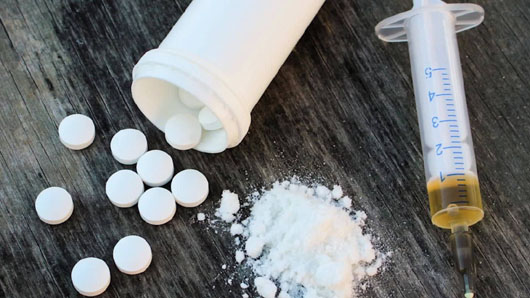by WorldTribune Staff, December 13, 2018
There were 63,632 drug overdose deaths in the United States in 2016, according to the Centers for Disease Control and Prevention’s National Center for Health Statistics. Fentanyl was involved in nearly 29 percent of those deaths.
Currently the most commonly used drug in overdose deaths, fentanyl poses “a significant threat to national security,” Michael Morell, the former acting director of the CIA wrote last year. “It is a weapon of mass destruction.”
 Fentanyl, the production of which is currently focused in China, is a synthetic opioid that is 80 to 100 times stronger than heroin or cocaine, according to the U.S. Drug Enforcement Agency (DEA).
Fentanyl, the production of which is currently focused in China, is a synthetic opioid that is 80 to 100 times stronger than heroin or cocaine, according to the U.S. Drug Enforcement Agency (DEA).
One kilogram of fentanyl purchased from China for $3,000 to $5,000 can generate revenue of up to $1.5 million in the U.S., Paul Knierim, deputy chief of operations in the Office of Global Enforcement for the DEA, told a congressional panel in September.
China agreed at a trade summit with the U.S. this month to regulate fentanyl as a controlled substance.
The DEA said that fentanyl is added to heroin to increase its potency, or is disguised as highly potent heroin. Although many drug users think they are buying heroin, they don’t know they’re buying fentanyl.
“There’s never been a drug like fentanyl before,” said Josh Bloom, senior director of chemical and pharmaceutical research at the American Council on Science and Health. “For street drugs, this absolutely destroys anything else in terms of lethality and danger.”
In April of this year, Nebraska State Trooper Sam Mortensen found 118 pounds of fentanyl when he stopped a truck marked “U.S. Mail” which he spotted swerving onto the shoulder along Interstate 80.
That much fentanyl could kill 25 million people, Bloomberg noted in a Dec. 12 report.
“Is that even believable? Can you even imagine?,” President Donald Trump said in October when Mortensen was honored at the White House for making one of the largest fentanyl seizures in U.S. history.
Even a small amount of the opioid – the equivalent of a few grains of salt – can be lethal.
Bloomberg noted that “Law enforcement officers and first responders have been warned to handle fentanyl with extreme caution; some have fallen seriously ill after getting it on their skin or clothing.”
National security analysts say that fentanyl is also being used as a weapon by terrorists.
If ground-up fentanyl is placed on everyday objects, people could easily put their fingers in their mouths or rub their eyes and have a deadly reaction, said Bloom, the American Council on Science and Health official.
Bloomberg noted that “Containing a fentanyl attack would be difficult for police and emergency medical officials. Overdoses of the drug are hard to reverse with existing formulations of antidotes such as the Narcan nasal spray.”
Narcan is carried by many police and paramedics, but people incapacitated by fentanyl frequently require multiple doses. Even some police and other emergency officials who’ve mistakenly ingested or absorbed fentanyl have needed multiple blasts of Narcan to be revived.
A video distributed to law enforcement in August by U.S. Customs and Border Protection warns against using hand sanitizer and says those who have touched fentanyl shouldn’t touch their eyes, nose or mouth.
In September, the U.S. Biomedical Advanced Research and Development Authority (Barda) signed a potential $4.6 million contract with Opiant Pharmaceuticals Inc. to produce a reliable single-dose fentanyl antidote.
“Fentanyl-based drugs have been used in conflicts in other countries, so we know it’s possible, and we need to be ready to save lives and protect Americans from potential health security threats,” said Barda Director Rick Bright.
In 2002, 50 armed rebels held more than 800 hostages in a crowded theater in Moscow, demanding the withdrawal of Russian forces from Chechnya. After a few days, Russian forces used a gas, reported by state news agency Interfax to be fentanyl, to incapacitate the attackers, though more than 100 hostages were also killed.
Opiant, based in Santa Monica, California, plans to test a nasal-spray version of a drug called nalmefene with the goal of counteracting fentanyl in one shot. In addition to the Barda deal, Opiant scored a $7.4 million grant from NIDA earlier this year to develop the new antidote. It is aiming to file for Food and Drug Administration approval in 2020.
“Nalmefene is five times more potent than naloxone,” Roger Crystal, chief executive officer of Opiant, said. “It’s fighting fire with fire.”
“Because we’re in a fentanyl crisis, there’s more fentanyl around, and for that reason the ability to get hold of it and getting it into the wrong hands isn’t that hard,” Crystal said.
Check Out Geostrategy-Direct __________ Jump Start the U.S. Media
